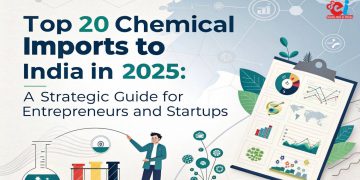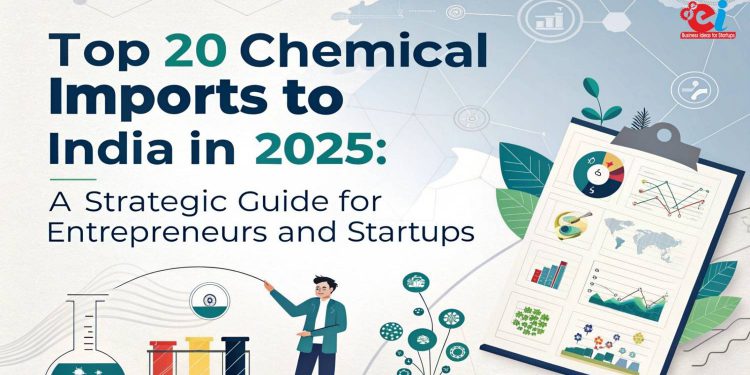As one of the fastest growing Chemical Import market globally, India enjoys a robust export footprint in numerous chemical segments. However, the country’s integration into global value chains remains underdeveloped as it continues to rely on imports for several essential chemical raw materials and intermediates. In FY2024-25, India’s chemical imports were pegged at over USD 54 billion, showcasing a substantial domestic demand along with local capacity gaps that can be targeted through backward integration and vertical chemical chain models.
For entrepreneurs and startups, India’s top chemical imports provide benchmarks for market opportunities, pre-existing trading relationships, and investment scope for local substitution. This post tells about the twenty most significant Chemical Imports along with what makes them important, and the industries they represent.
20 Chemical Imports Businesses are:
1. Crude Petroleum and Petrochemicals
Reason for Chemical Import: Manufacturing of these products related to crude oil is not done sufficiently in the country. Petrochemical derivatives such as naphtha, reformate, and toluene are important for the production of plastics, fibers, and polymers.
Business Insight: Opportunities exist in setting up secondary refining units, aromatics recovery plants, and polymer downstream industries.
2. Phenol
Import Reason: Domestic manufacturing does not meet the needs of the market for laminates, pharmaceuticals, and epoxy resins.
Primary Suppliers to India: Thailand, Singapore, and the USA
Phenol Insight: India requires regional phenol production units with cumene integration to improve economic strength.
3. Acetone
Used in: Pharmaceuticals, paints, adhesives, and as a byproduct of phenol plants.
Import Insight: Over 150,000 tonnes imported annually.
Investment Opportunity Explained: Coupled phenol-acetone production units offer excellent ROI.
Related: India’s Chemical Industry: Sector Overview
4. Methanol
Key Feedstock For: Formaldehyde, acetic acid, biodiesel, and hydrogen.
Import Partners: Saudi Arabia, Iran, Qatar
Opportunity: India’s gas-to-methanol or coal-based methanol projects are in early phases—scope for green methanol ventures.
5. Potassium Carbonate and Potash
Used in: Fertilizers, glass, soap, and pharmaceuticals.
Market Status: 100% import dependent.
Entrepreneur Tip: Work with contract imports or JV setups with Belarus and Canada; explore seaweed-based potassium derivation.
6. Caustic Soda (Flakes & Liquid)
Note: Though India is a large producer, specific grades and regional shortages lead to imports.
Opportunity: Local niche-grade production and setting up inland logistics hubs.
7. Soda Ash (Sodium Carbonate)
Application: Found in glass, detergents, and metallurgy.
Business Potential: Domestic capacity lags behind demand, imports mainly from Kenya, Turkey, and USA.
8. Toluene Diisocyanate (TDI)
Application: Polyurethane foams, adhesives, and coatings.
Import Volume: India imports 80-90 percent of its TDI demand.
Startup Insight: TDI manufacturing is complex but offers high returns if further integrated with nitric acid and toluene streams.
9. Phosphoric Acid
Used in: Fertilizers alongside food-grade acids and detergents.
Export Countries: Jordan, Morocco, China
Business Opportunity: Consider establishing green phosphoric acid plants utilizing bones, food waste, or biophosphate substrates.
10. Adipic Acid
Reason for Import: Included among the value-added chemicals in production of nylon, polyurethane, and plasticizers.
Entrepreneur Insight: High-value engineering chemicals which are in demand and will sustain—ideal for integrated chemical parks.
11. Maleic Anhydride
Applications: Used for construction of polyester resins, lubricant additives, and some pharmaceuticals.
Current Scenario: Imports come from Middle East and China.
Startup Scope: Potential in green production through bio-based butane derivatives from biomass.
12. Ethylene Vinyl Acetate (EVA)
Market Need: Primarily used in footwear, packaging, and solar panels.
Import Dependence: 70% of domestic EVA needs sufficed by imports.
Business Edge: Backward integration opportunities for solutions from ethylene and acetic acid units.
13. Chlorinated Paraffins
Reason for Import: Used as flame retardants and plasticizers.
Business Strategy: India is gradually building capacity—need compliance with REACH regulations.
14. Propylene Oxide
Applications: Flexible foams, surfactants, elastomers
Strategic Insight: Required for PU-based products.
Investment Need: Allocating CAPEX presents strong strategic returns due to India’s growing construction and automotive markets.
15. Titanium Dioxide
Reason for Import: Primary use in paints and cosmetics as white dyes in plasters, inks, and plastics.
Current Status: Relies heavily on imports from China and EU.
Startup Opportunity: Emphasis on producing anatase and rutile grades for local consumption; there are ilmenite deposits within India.
Related: Export and Import Dynamics of India’s Chemical Sector
16. Isopropyl Alcohol (IPA)
Used for: Pharma, personal care, disinfectants.
Demand Surge: The pandemic period has caused India to become overly reliant on imports.
Investment Edge: Indigenous production from propylene can fulfill demand in the hygiene industry.
17. Sodium Cyanide
Application: Used in dyes, agro-chemical intermediates, and gold extraction.
Import Reason: Dangerous to handle and produce domestically.
Opportunity: Invest strategically with specialized industrial safety infrastructure.
18. Hydrogen Peroxide (H₂O₂)
Used for: Electronics, bleaching, and wastewater treatment.
Market Gap: Less available in Eastern and North-Eastern parts of India.
Insight: Textile and paper industry hubs can successfully operate medium-scale units.
19. Silicone Oils and Fluids
Used for: Textiles, lubricants, cosmetics, and pharmaceuticals.
Dependence: The country lacks production of base-grade silicone.
Startup Potential: Substitution of imports via joint ventures with foreign silicone companies can become feasible.
20. Epichlorohydrin
Used for: Production of epoxy resins, strengthening compounds for papers, and water treatment.
Sources of Imports: China, Korea, and the USA.
Vision: There is potential for local production based on glycerin feedstocks where biodiesel byproducts are abundant.
Conclusion: Business Opportunities and Insights
Without a doubt, the import landscape contains abundant resources for new entrepreneurs and startups where data is not simply a statistic but a visual blueprint with:
- Marked unmet demands catered locally
- The ability to capitalize on the import-export market as official distributors or agents
There are opportunities for transferring technology, forming Joint Venture (JV) partnerships, and local production under India’s Atmanirbhar Bharat and PLI initiatives.
About NPCS
With support from Niir Project Consultancy Services (NPCS), you can obtain comprehensive services from feasibility studies to DPRs, identifying technology partners, navigating regulations, and crafting customized market entry plans specific to these chemical industries.

















